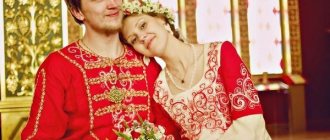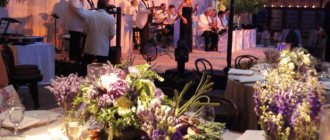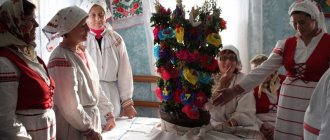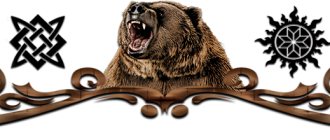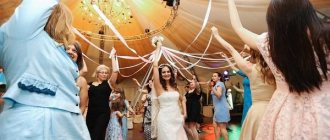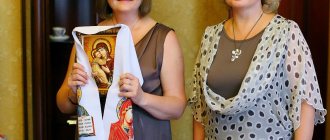The Russian style was formed in the 8th century in Kievan Rus. Its distinctive features are the richness of decoration and brightness of colors. The style is reminiscent of a fairy tale. A striking example for the formation of a general picture of style attributes is the fabulous work “Morozko”. In those centuries in Rus', the wedding ceremony was considered sacred; it required a lot of preparatory stages and events. The newlyweds were expected to carefully prepare for the celebration.
Nowadays, you reserve the right whether to observe all the nuances or make a celebration with an emphasis on style. In any case, the wedding will be bright and memorable.
Traditions, rituals and customs
The main stages of the celebration are:
- Collusion. Previously, the bride and groom might not even know each other before the wedding. Everything was decided without their direct participation. Parents often chose the wedding day themselves, discussed the size of the dowry and all the expenses for the celebration.
- Matchmaking. The groom, together with matchmakers (friends, godparents, parents) went to the bride's house to get married. Traditionally, the matchmakers were always refused the first time; they could give consent a second or only a third time. Matchmaking, after the consent of the parties, always turned into a real holiday with songs, dances and rich feasts.
- Hen-party. This event took place the night before the wedding. The girls went to the bathhouse, sang songs, and performed fortune telling by candlelight for the future of the bride.
- Bachelor party. This event was a lonely trip of the groom to wash himself in the bathhouse. According to tradition, after this trip the guy came home and went to bed; he had to remain silent until he met the bride.
- Ransom. Despite all the decisions and agreements, the groom had to pay the bride's parents for abuse. Also, relatives of the bride arranged all sorts of competitions and obstacles for the groom on the way to the bride. The young man needed to demonstrate strength, intelligence, generosity and kindness. When all the obstacles were over, the last thing left was to pay the agreed amount to the parents and find the bride. She was hidden not in the house, but in the yard or even with neighbors. The bride was guarded by her brother or father, who also had the right to demand a ransom. After all the competitions, the bride and groom received their parents' blessing and sat down for a small feast in the bride's house.
- Wedding and registration. The first step to forming a new family was going to church and holding a wedding ceremony. Only after the wedding was the marriage registered. This can be either an outdoor ceremony or registration at the registry office or even in a banquet hall.
- Celebration. The real fairy tale and fun begins after all the rituals. The celebration consists of a rich feast, the performance of Russian folk songs and playing musical instruments, dancing, round dances, competitions (running in sacks, collecting bagels on a pole or tree, tug of war), sleigh rides with dogs or on a cart with horses, all this with songs and the ringing of bells.
- Wedding night or basement. The place for the wedding night of the young couple was arranged very carefully. In a closet, barn or bathhouse in the groom's house, a high bed was placed, which was covered with feather beds and a bedding from the bride's dowry. Various amulets were laid out on the bed by the women who were bedridden. Logs, a poker, a juniper branch and a frying pan were placed under the bed. These items were supposed to protect the young from evil spirits. The newlyweds were escorted to the bedchamber by the whole crowd and locked. The girl always took off the guy’s boots, thereby showing humility in front of her husband. And she always asked permission to lie next to him. The morning after the wedding, the newlyweds’ bed was shown to all relatives to convince them of the bride’s innocence. Otherwise, the girl could be returned to her parents' house, a collar would be hung around the matchmaker's neck, and the father would be given a glass of wine with a hole in the bottom. The whole family was brought shame.
- Bad wedding. It is held on the second day and serves as an event for the entertainment of guests. The bride and groom are chosen from those present and made into mummers. The man is dressed up as a bride, the woman, respectively, as the groom. Their retinue also includes mummers (gypsies, buffoons, and so on). The whole cheerful crowd of this procession goes for a walk through the village, the “young” treat passers-by with snacks and vodka, and ask for money in return.
Stylistics, symbolism and attributes
In order for the wedding day to go according to tradition, the following attributes must be present::
- Rushnik . This is an embroidered piece of fabric in the shape of a long towel. It was the protection of the family and clan, it was passed on from one generation to another. The towel was used to present a loaf or other treat. It was forbidden to step on the towel, as the family would lose the protection of the spirits and doom itself and its descendants to misfortune.
- Homespun towel . It was used to bind the hands of young people during betrothal. Afterwards, the towel was given as a dowry to the bride.
- Loaf . Sweet bread beautifully decorated with curls, flowers, braids. The richer the loaf, the happier and more prosperous the life of the young people was. With the help of the loaf, a ritual of honor to Mother Earth and Father Sky was performed.
- Rings . With their shape they symbolized the sun, which was held in high esteem by the Slavs, then still pagans. The circle is a symbol of harmony, unity and fidelity.
- Wreath of flowers . It was worn by both the bride and groom. A wreath is a symbol of love and sun rays hidden in herbs and flowers.
- Wedding party . An embroidered amulet signifying both the creative and destructive principles of the sun. It means the interweaving of two families and serves as a talisman for a new family. The wedding dress was given by the parents after the wedding ceremony.
Location
A wedding in a folk style is best held outdoors, but it all depends on the vagaries of the weather.
Summer and spring
- rustic courtyard with wooden buildings;
- picturesque lake;
- Birch Grove;
- boron;
- a park;
- wheat field;
- country wooden estate.
Winter and autumn
- banquet halls;
- restaurants;
- cafe;
- wooden ancient hut;
- tower;
- theater halls.
It is important to simply choose the interior to match the folk style or organize it yourself.
Russian wedding style: features of preparation
Before you begin organizing a celebration in the Slavic style, you need to become more familiar with wedding rituals and traditions. Of course, many customs are not relevant in the 21st century, but reviving forgotten rules means paying tribute to our ancestors and helping guests learn more about their own history.
Slavic wedding rituals:
- Matchmaking. In Rus', most often, young people did not know each other. The mate for their child was chosen directly by parents and older family members. Currently, matchmaking has “transformed”, since young people already know each other. But to maintain the Slavic style of the celebration, you can arrange a matchmaking performance;
- Collusion. The custom will find its place in our time. During the agreement between families, the time and place of the holiday is discussed, the budget of the celebration and other pressing issues are discussed;
- Bachelorette/bachelor party. In the times of our ancestors, seeing off a bachelor’s life took place according to established rules: at bachelorette parties, girls sang sad songs, combed the bride’s hair, and she cried throughout the evening; the guys, in turn, went to the bathhouse completely alone and had to remain silent until the wedding itself. Currently, bachelor and hen parties are amazing in their scope. Depending on the desires of the young people, these can be themed parties or loud celebrations in a club or outdoors;
- Wedding. Modern newlyweds are increasingly returning to the wedding ceremony. This is how they emphasize their love and devotion to each other. In the modern world, Slavic weddings take place only after official registration at the registry office;
- Festive feast. No wedding can do without tables that are bursting with delicious and delicious treats! And a wedding in the Old Russian style requires a special approach to choosing a festive menu;
- The wedding night. For ancestors, the first wedding night caused special awe, because the young people were each other’s first. However, the custom of the first wedding night has survived to this day.
Decoration of the banquet area
The true Russian spirit will be brought into the interior by:
- old Russian stove;
- brightly painted dishes;
- wooden utensils with red and gold ornaments;
- dried flowers;
- sheaves and ears of corn;
- nesting dolls;
- baskets;
- rocker arms and buckets;
- sleighs and wooden carts;
- wicker fences;
- bunches of ripe viburnum;
- rowan beads;
- fagots of bagels;
- fagots of garlic and onions;
- dried berry branches;
- apple motifs in decor;
- painted samovars;
- wooden bowls and spoons;
- button accordions;
- felt boots and bast shoes;
- kokoshniks;
- clay dishes;
- an abundance of satin ribbons;
- wreaths of fresh flowers;
- linen embroidered tablecloths;
- wooden tables;
- wooden benches with carvings on the backs;
- figures of swans.
The arrangement of tables and benches can be very diverse. In the old days, tables were placed in a long row or in the letter P. In the center of the table, an area for the young was decorated, or a separate table was placed for them.
Decor in ancient Russian style
When organizing a themed celebration, newlyweds need to understand that to create a true Russian holiday atmosphere, it is not enough just to dress up in old Russian outfits.
A themed wedding is not a theatrical performance with dressing up in period costumes. This is a whole set of correctly selected surroundings, attributes with elements of the necessary decor.
It is these little things, combined with the appropriate color scheme and outfits of the bride and groom, that give a special, unique flavor to the wedding celebration.
The following attributes will help you create the overall style of a Russian wedding:
- towels and napkins embroidered with bright floral patterns and ornaments in traditional colors;
- kokoshniks and elegant bright scarves;
- wooden dishes painted using Khokhloma and Gzhel techniques;
- painted wooden dolls;
- Zhostovo trays with bright floral patterns on a black background;
- copper or brass samovars;
- rosy bagels and rich crumpets;
- wreaths of wild flowers;
- ancient musical instruments: accordion, gusli or balalaika.
Careful preparation of a Russian wedding and studying ancient rituals will require a lot of time, but the result is worth it: the wedding will be bright, cheerful and truly unforgettable.
Design elements
The place of the wedding celebration is decorated with household items and everyday life items from the Old Slavonic hut, such as:
- Wooden spoons and bowls painted with bright colors.
- Woven bast shoes.
- Birch brooms for a bath.
- Cast iron and grips.
- Clay mugs and jugs.
- Small sheaves of wheat.
- Knitting with apples.
In the corner of the banquet hall you can place a real rustic corner: hang a homespun carpet with a pair of swans on the wall, put an old spinning wheel, place a wooden table covered with an elegant tablecloth with embroidered traditional patterns.
An installation of dried flowers, ears of ripe wheat, red-sided apples, and rowan bunches completes the overall composition of the Old Russian hut.
Guests will be absolutely delighted with such rarities and will certainly choose this cozy place for a photo shoot.
At the weddings of old Rus', the newlyweds rode up to the celebration in a decorated horse-drawn carriage with jingling bells on the horses' manes.
In the realities of a modern city highway, it is difficult to imagine a wedding procession of horse-drawn carriages. Therefore, to organize transportation of guests and newlyweds around the city to the place of registration and wedding banquet, they use familiar and convenient vehicles.
But it is recommended that the bride and groom arrive at the venue for a Russian-style wedding celebration in an open, decorated horse-drawn carriage. The coachman should drive in old Russian clothes: a caftan and a cap, with ringing bells hung on the arch of the horse harness.
A wedding cortege with loud, daring shouts, a cheerful accordion or the trill of pipes drives up to the place of celebration and, as it were, notifies in advance of the beginning of a bright, daring Russian wedding.
If it is not possible to order a horse-drawn carriage for the wedding, then in this case you can decorate the white wedding car of the bride and groom with satin ribbons, embroidered with Russian ornaments and bouquets of wild flowers.
Invitations, bonbonnieres and other accessories
Invitations for a themed wedding should be designed in accordance with the chosen overall style. Most often, for invitations, they use the traditional postcard format with bright paintings of national ornaments;
- Khokhloma with colorful patterns in red, black and gold tones.
- Gzhel with blue and white ornament.
- Zhostovo floral patterns in red, gold and black tones.
In keeping with Russian style, invitations may feature images of nesting dolls, a swan couple, or newlyweds in old Russian wedding dresses.
In addition to the usual postcards, invitations to a Russian wedding can be placed in small nesting dolls or tied in the form of scrolls with wax seals and given to the guests of the holiday.
Original invitations in the form of a balalaika, a towel, a red-sided apple, or a sprig of viburnum can highlight the chosen theme of a Russian wedding.
Invitations
The design of invitation cards in Russian folk style should fully convey the spirit of celebration. The following options are suitable:
- invitations with painted patterns and folk prints;
- invitations in the shape of nesting dolls;
- personalized invitations with Khokhloma;
- invitations with the image of the bride and groom in folk attire.
The text inside the invitations will look very interesting in the old Russian style of writing. In addition to the basic wedding information on the organization and celebration, the postcards should indicate the approximate dress code for guests.
Hair and makeup
For a Russian-style wedding, it is best to have a wedding hairstyle with braids or intricate braids. If you don't like this option, loose, slightly wavy hair is also suitable. Makeup should be natural and light, the only thing that can be done is to paint your lips with bright red lipstick if it is combined with other details of the festive look. Both a French manicure and a plain manicure with national patterns are suitable for a wedding manicure.
Dress code for guests
The ideal option for a Russian wedding would be to select outfits for all guests and newlyweds in the same style. To implement such an idea, it is best to rent costumes for guests. Of course, it is worth taking into account the wishes and mood of the guests. If you categorically refuse to wear the proposed clothes, you can ask the guest to complement his image with details of folk style - hairstyle, headdress, ribbons, scarf, beads, and so on. All these elements, when combined into one whole, will give the celebration a truly Russian folk flavor.
Also, if guests do not agree to wear theatrical costumes, you can ask the female half to choose floor-length dresses with three-quarter or maxi sleeves and in the same color scheme, or floor-length sundresses with a white shirt. And for the male half, I recommend choosing simple light shirts or shirts without ties and bow ties, complete with a simple dark-colored bottom.
Summer wedding ideas
In the warm season, the entire celebration can be held outdoors. It is enough to set up several tents so that guests have a place to rest, and a canopy from occasional rain. To do this, you can use either the plot of a private house or rent space at a tourist center or next to a hotel located in a picturesque corner of nature. It’s better to sign at the registry office the day before so that you don’t have to go to the city just to fill out the documents. How can you diversify the holiday?
- Hire carriages or phaetons drawn by Oryol trotters.
- Engage all present guests in a round dance.
- Organize competitions for tug of war, the best male and female dance, blind man's buff and lapta.
- Girls can weave wreaths and give them to boys.
- If the weather is hot, no one will refuse water procedures in the nearest body of water, you can organize competitions in diving or quickly getting a “drowning” girl out of the water.
- Folk songs under a night sky full of stars - what could be more romantic?
- You can offer guests a colorful night show - a Russian girl's dance in outfits illuminated by fluorescent lamps. It looks and sounds simply amazing.
In summer there are many opportunities to organize an unforgettable holiday.
Wedding menu
You won’t have to come up with anything on the menu; it will be traditional Russian cuisine. The following must be present on the tables:
- borscht or cabbage soup;
- ear;
- meat and fish pies;
- pies, cones, knishiki, pies and buns;
- loaves;
- pancakes and all kinds of fillings for them: fried mushrooms, caviar, berries, sour cream, and so on;
- lightly salted fish;
- pickled cucumbers and tomatoes;
- canned mushrooms;
- baked goose or pig;
- Uzvars and compotes;
- dumplings with different fillings, including dumplings with cherries as a dessert;
- whipped cream and berries;
- honey apples;
- pike, chicken carcasses that can be stuffed with porridge, eggs, and so on;
- mint gingerbread, lollipops, bagels;
- an abundance of simple homemade vegetables and herbs: tomatoes, cucumbers, parsley, dill and so on;
- whole boiled potatoes with greasy cracklings and fried onions.
This is not the entire list of possible dishes, but this will be enough to convey the folk atmosphere.
Alcohol at a Russian wedding should also be originally Russian:
- homemade mead;
- moonshine in containers with national ornaments;
- vodka in glass bottles;
- aromatic wine;
- berry liqueurs;
- herbal tinctures.
Winter Russian fairy tale
Winter is a traditional Russian season, Napoleon recognized this. You don’t even need to invent anything for the folk festival; winter fun has long been perfected by generations:
- skiing, sledding, skating on slides, on ice or in the winter forest;
- competitions for sculpting snowmen, carving ice sculptures, drawing artistic figures on a blank sheet of snow;
- construction and assault of an ice fortress and snow battles;
- riding in troikas with bells, dog and reindeer sleds.
A memorable Russian wedding requires space. The best solution would be to rent the territory of a forest boarding house, a nature reserve or a tourist base, stylized as antique. Outdoor games and dancing on a snow-covered meadow will keep you from freezing; you can offer guests to warm up with hot tea with bagels or dry bread during the break. It is necessary to provide warm rooms for feasting and relaxation, because there can be quite a noticeable frost outside. A real, hot Russian stove creates a special comfort.
Cake
This style is characterized by multi-tiered cakes covered with fondant and painted with folk patterns.
Features of ancient Russian wedding rituals
If we talk about holding a wedding in Rus', then you need to understand that it was a long and very noisy celebration. The guests at the wedding were all the village residents.
It all started with matchmaking. Matchmakers came to the girl's parents and agreed on the wedding. After an affirmative answer, the groom’s parents came to the house and gave the bride an agreed-upon gingerbread. He was a kind of parting word to his future daughter-in-law.
The bridesmaid ceremony always ended with a handshake. The fathers of the bride and groom put their children's hands into each other and hit them with one mitten. Sometimes it happened that parents hit the pie against the pie or broke it in half. This symbolized the inviolability of the contract. After this, it was no longer possible to cancel the wedding.
A bachelorette party was a must. Her friends and the bride sang a song and removed the “will” from her hair. This was the name of the colored ribbon, which symbolized freedom and maiden beauty. Most often it was passed on to a younger sister or an unmarried friend.
On the wedding day, early in the morning, someone from the groom’s side came to the bride with a gift and took the return gift. Only after this the groom appeared. Next came the ransom. The bride's friends did not let the groom in until he showered them with gifts and completed some tasks.
After the ransom, the wedding ceremony followed. As soon as the newlyweds returned home from church, everyone sat down at the table. The bride's parents sat on one side of the table, and the groom's on the other. The feast was long and noisy. At the end of the celebration, the newlyweds were escorted to the bedroom.
Photo zone design
Traditional Slavic wedding: we design invitations and wedding cake
Making an invitation is one of the main stages of preparing for a wedding. To design Slavic invitations, use pastel colors - white, dark green, discreet red. To ensure that your guests understand the idea of the celebration, write the invitation text in Old Church Slavonic, and attach a translation card to the invitation. You can use an ornament or ethnic sketches as a design.
Bride's image
What to pay attention to:
Cloth
According to tradition, the bride's attire in the old days consisted of a long white undershirt, a wedge-shaped red sundress, high-heeled boots and a folk headdress. Nowadays, the most popular outfit is a light A-line dress with embroidery as decoration. Moreover, the dress can be either a plain white color or a variegated, multi-colored one. The sleeves of such a dress must be long or three-quarters, it can be with lace or fur trim at the wrist, tight-fitting or with a “lantern” cut. There is a wide belt at the waist.
The dress can be complemented with a caftan or sheepskin coat, which will also vary depending on the time of year.
Shoes - shoes or red boots with heels. They can be any color, even painted with patterns.
Makeup, hairstyle and headdress
The bride should be as natural as possible. The ideal option would be with nude makeup. Bright accents on the lips are also welcome.
Braid is a hairstyle of Russian folk style. Now there are many variations and techniques of braiding. An alternative would be small curls, neatly gathered into a low ponytail and laid over one shoulder. Straight long hair, which can be complemented with ribbons, flowers, and a wreath, will also look beautiful.
A kokoshnik with lace trim at the forehead and many patterns always complemented the festive image of a Russian maiden in the old days. Now you can pay tribute to the past and order the production of a kokoshnik that fits the entire wedding style.
Also, a long veil, a wreath of wild flowers or a headband embroidered with beads, and crowns with tassels near the face will be harmoniously suitable for the style.
In the winter season, you can’t do without long floral shawls, downy scarves, painted scarves, and fur hats.
Bouquet
A bouquet of delicate cornflowers, buttercups, field daisies, mallows and any other wild flowers will perfectly complement the feminine image of the bride. You can also add ears of corn, small heavenly apples, and branches with viburnum berries to the bouquet.
You should not give preference to bouquets consisting entirely of roses, orchids or lilies.
Entertainment
As a thematic show program, guests can be offered a performance by a folk dance group or cover group that will perform both modern and folk songs. Be sure to include Russian wedding traditions in the festive banquet scenario. For example, meeting the newlyweds with bread and salt is perfect for such a themed celebration.
Don’t forget to arrange a themed photo zone at a Russian-style wedding - a small corner with benches and a table with a samovar, where guests can take a couple of unique shots. Minimum costs, and the photos will be very atmospheric!
Offer your guests various games and competitions in the form of Russian amusements that will reveal real heroes, needlewomen, etc. For such a celebration, funny skit competitions based on good Russian fairy tales, for example, “Three Sisters”, “Turnip”, “Kolobok” are perfect.
Groom image
For the groom's look, wide trousers, plain or with vertical stripes, and a linen shirt embroidered with Russian patterns are suitable. You can complete the look with a vest, soft high boots in black and a wide tie belt at the waist. You can also put a cap with flowers on one side on the groom’s head.
If desired, trousers can be replaced with trousers, and a shirt with a shirt.
How to dress for guests
Guests also dress according to the spirit of the celebration. For women, it is best to wear national-style sundresses or antique-style dresses. The same goes for men: formal black suits will look at least ridiculous at this celebration of life.
During the winter season, the newlyweds and all invitees must take into account prolonged exposure to the street. Therefore, you need warm fur boots, high fur boots or felt boots, insulated pants, fur coats and short fur coats made of natural fur, astrakhan fur or drape, with fur cuffs. It is also recommended to wear old-style fur hats on your head.



